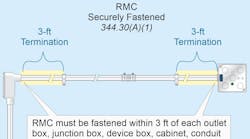Q. What are the supporting and securing requirements for Type MC cable?
A. The rules for securing and supporting Type MC cable can be found in Section 330.30 of the Code. The requirements can be summarized as follows:
- Type MC cable must be supported and secured by staples, cable ties, straps, hangers, or similar fittings, designed and installed so as not to damage the cable.
- Type MC cable, with four or less conductors sized no larger than 10 AWG, must be secured within 12 in. of every outlet box, junction box, cabinet, or fitting and at intervals not exceeding 6 ft.
- Type MC cable must be supported at intervals not exceeding 6 ft. Cables installed horizontally through wooden or metal framing members are considered secured and supported where such support doesn’t exceed 6 ft intervals.
- Type MC cable can be unsupported where the cable is: 1) Fished through concealed spaces in finished buildings or structures, where support is impracticable, or 2) Not more than 6 ft long from the last point of cable support to the point of connection to luminaires or other electrical equipment within an accessible ceiling. Type MC cable fittings are permitted as a means of cable support.



